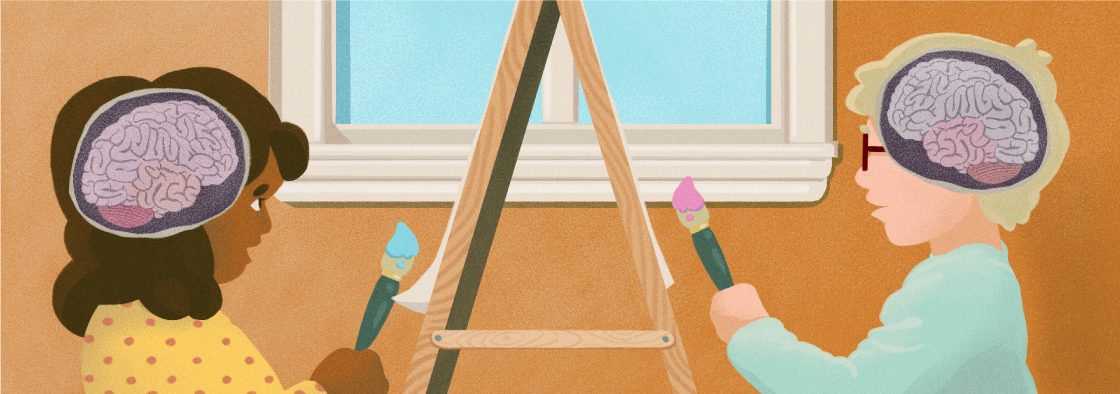THIS ARTICLE IS MORE THAN FIVE YEARS OLD
This article is more than five years old. Autism research — and science in general — is constantly evolving, so older articles may contain information or theories that have been reevaluated since their original publication date.

Listen to this story:
The long-held finding that autism is more common in men than in women has multiple underpinnings1. Among these are how autism is defined and diagnosed, how men and women with autism differ in their behavior and how biological and sociocultural factors related to sex and gender come into play.
Girls with autism tend to carry more genetic mutations associated with the condition than do boys with autism. And some risk mechanisms for autism, such as the interplay between genetics and early-life stress, hormonal activity and immune responses, might be particularly important in boys.
The brain may give us further clues about why men and women differ in both their risk of autism and in its behavioral presentation. Some of the atypical brain features characterizing individuals with autism seem to exist in both men and women with autism and may reflect factors independent of sex or gender. But other unusual features appear to be different in men and women with the condition and may tell us something about how autism differs by sex and gender.
Based on the evidence so far, researchers have hypothesized that two patterns of male-female differences in autism exist in the brain, with distinct implications for autism’s origins1.
One hypothesis predicts that if women are somehow insulated from autism — a phenomenon termed the ‘female protective effect’ — the brain abnormalities in women who meet the clinical threshold for an autism diagnosis should be more substantial than those in men who meet the same threshold.
For example, women with autism might have larger structural abnormalities in particular brain regions, or show differences in more brain regions, than do men with autism when compared with controls of the same gender.
Some small studies, involving fewer than 10 toddler girls with autism, have shown that girls with autism have more substantial differences in the volume of gray matter in the cerebral cortex than do boys with autism when compared with their typically developing peers2,3.
We’ll need to determine whether these larger differences are related to why these girls cross the threshold for autism diagnosis. For example, clarifying the relationship between a heavy burden of genetic mutations and excessive brain changes in girls with autism might tell us more about how and why girls in general are protected from autism.
Structural shifts:
According to another hypothesis, if different causes of autism lead to the same core symptoms in both men and women, and if changes in the brain mediate these symptoms, we would expect to find that men and women with autism differ in the kinds of atypical patterns of brain activity or structure they show. We might also expect men and women to have only random overlap in which brain regions show such atypical patterns.
Some studies over the past five years, including between 22 and 53 women with autism, have borne out these expectations. They have shown that brain overgrowth appears only in some toddler boys (those with regression) but not in girls4.
Changes in the size and structure of the corpus callosum — the band of fibers that connects the brain’s hemispheres — also differ. Relative to same-sex neurotypical peers, boys with autism have a smaller section of these fibers linked to the orbitofrontal cortex, a region at the front of the brain involved in decision-making and the sense of self. By contrast, girls with autism have a smaller callosal region linked to an adjacent region, the anterior frontal cortex5.
The overall pattern of changes in gray and white matter volume across the brain associated with autism also significantly differs in men and women6. Across a wide age range, men and women with autism diverge, relative to same-sex peers without autism, in the extent of brain tissue folding at the orbitofrontal cortex, in particular7.
A key question is how the brain characteristics of men and women with autism relate to similarities or differences in their behavior. We also need to investigate whether the brain variation largely stems from different causes in men and women with autism. If that turns out to be the case, we should prioritize intervention and support strategies tailored to the different needs of men and women with autism.
Gender contrast:
Some researchers have hypothesized that mechanisms that directly drive — or are closely associated with — sex differentiation or gender socialization might be involved in autism1. Contrasting how the brains of typical men and women differ versus brain differences associated with autism in men and women might help us generate specific hypotheses about autism’s origins.
For example, one study has shown that atypical changes in brain volume in women with autism compared with neurotypical women resemble brain volume differences between neurotypical men and women6.
This ‘masculinization’ suggests that mechanisms involved in the emergence of autism in women may partly overlap with both biological and sociocultural processes leading to typical sex and gender differences.
Interestingly, the same study also found a trend suggesting that the brains of men with autism are ‘feminized.’ These results indicate that there might be critical differences between men and women in the mechanisms that lead to autism.
A study published earlier this year showed that men with autism have less folding in their orbitofrontal cortex than neurotypical men do, but women with autism show no such decrease compared with neurotypical women7. A meta-analysis showed that this region is marginally larger in neurotypical women than in neurotypical men8.
The meaning of this coincidence is complicated. If we assume that the smaller orbitofrontal cortex in typical men reflects some of the increased general risk for autism in men, the still smaller degree of cortical folding in men with autism might indicate brain processes associated with an even greater risk.
Women with autism probably do not share the same risks because they do not show decreased folding in this region. For them, other sources of risk may be at play. It’s also possible that the larger volume of the orbitofrontal cortex in typical women has a ubiquitous protective effect.
Continuing challenge:
Investigating how the brains of men and women with autism are different and similar, and contrasting them with typical sex and gender differences, can help generate new hypotheses about the origins of autism. But that’s not enough.
We need to follow boys and girls with autism over time, and study their brain development and changes at different stages of life. Importantly, these studies should also look at underlying factors in the causal chain, including gene sequence and expression, environment, hormone levels and sociocultural factors.
Understanding the role of the brain in the emergence of autism is a continuing challenge. The idea that brain scans can be biomarkers is an appealing one, particularly as the technology becomes more sophisticated. But autism’s innate heterogeneity makes it difficult to find common patterns, even with large samples accumulated from collaborative studies9,10.
Most studies are also crippled by the small numbers of women participants and, more fundamentally, by the difficulty of diagnosing autism in women relative to men1.
To surmount these challenges, and to design better individualized interventions, we need scientists, clinicians and the autism community to collaborate to gain a more complete understanding of sex and gender similarities and differences in autism, including those in the brain.
Meng-Chuan Lai is assistant professor of psychiatry at the University of Toronto and clinician scientist at the Centre for Addiction and Mental Health in Toronto.

By joining the discussion, you agree to our privacy policy.